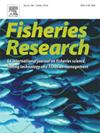Evaluating the metabolic response to temperature using otolith carbon isotopes as an intrinsic metabolic tracer in juvenile chum salmon Oncorhynchus keta
IF 2.2
2区 农林科学
Q2 FISHERIES
引用次数: 0
Abstract
The carbon isotopic compositions of otolith can be used to retrospectively estimate fish field metabolic rates (FMR) and are advantageous for practical applications, particularly for small-sized fish whose metabolic rates are challenging to measure in the field. Based on the proportional contribution of metabolism-derived carbon to otolith carbon, this study validated an approach for juveniles of the anadromous fish species, chum salmon Oncorhynchus keta, by integrating respirometry experiments and stable isotope ratio mass spectrometry (SIA). The isotopic results showed that the compositions of otolith carbon isotope (δ13Cotolith) values were negatively correlated with body mass, aligning with the mass-specific allometric theory. The ratio of metabolism-derived carbon in otoliths (Cresp) was calculated based on the carbon isotope compositions of the otolith, dissolved inorganic carbon in water (DIC), and diet. The results indicated that up to nearly 50 % of the carbon in juvenile chum salmon otoliths was metabolism-origin. Further, temperature gradient experiments showed that the Cresp values increased until around a temperature of 15℃ and fell significantly at 20℃, suggesting that the factorial FMR was restricted at temperatures exceeding the optimal temperature for metabolism (Topt). Thus, the relationship between metabolic rate and Cresp was validated within the temperature range of 9–15℃. Nonetheless, as a cool-water species, wild chum salmon rarely experience water masses above 15℃. Therefore, our results were feasible to estimate the FMR of juvenile chum salmon in the wild and could be used for reconstructing their metabolic histories, thereby providing insights into the metabolic strategies associated with migration traits.
耳石的碳同位素组成可用于回顾性估算鱼类的野外代谢率(FMR),在实际应用中具有优势,特别是对于那些野外测量代谢率具有挑战性的小型鱼类。根据新陈代谢产生的碳在耳石碳中所占的比例,本研究通过呼吸测定实验和稳定同位素比质谱法(SIA)对溯河鱼类大马哈鱼(Oncorhynchus keta)幼鱼的方法进行了验证。同位素研究结果表明,耳石碳同位素组成(δ13Cotolith)值与鱼体质量呈负相关,这与鱼体质量特异性异计量理论一致。根据耳石、水中溶解的无机碳(DIC)和食物的碳同位素组成,计算了耳石中代谢产生的碳的比率(Cresp)。结果表明,幼年大马哈鱼耳石中近 50% 的碳来自新陈代谢。此外,温度梯度实验表明,Cresp值在温度为15℃左右时增加,在20℃时显著下降,这表明因子FMR在温度超过新陈代谢最佳温度(Topt)时受到限制。因此,新陈代谢率与 Cresp 之间的关系在 9-15℃ 的温度范围内得到了验证。然而,作为冷水性物种,野生大马哈鱼的水质很少超过 15℃。因此,我们的研究结果可用于估算野生大马哈鱼幼鱼的新陈代谢率,并可用于重建其新陈代谢历史,从而深入了解与洄游特征相关的新陈代谢策略。
本文章由计算机程序翻译,如有差异,请以英文原文为准。
求助全文
约1分钟内获得全文
求助全文
来源期刊

Fisheries Research
农林科学-渔业
CiteScore
4.50
自引率
16.70%
发文量
294
审稿时长
15 weeks
期刊介绍:
This journal provides an international forum for the publication of papers in the areas of fisheries science, fishing technology, fisheries management and relevant socio-economics. The scope covers fisheries in salt, brackish and freshwater systems, and all aspects of associated ecology, environmental aspects of fisheries, and economics. Both theoretical and practical papers are acceptable, including laboratory and field experimental studies relevant to fisheries. Papers on the conservation of exploitable living resources are welcome. Review and Viewpoint articles are also published. As the specified areas inevitably impinge on and interrelate with each other, the approach of the journal is multidisciplinary, and authors are encouraged to emphasise the relevance of their own work to that of other disciplines. The journal is intended for fisheries scientists, biological oceanographers, gear technologists, economists, managers, administrators, policy makers and legislators.
 求助内容:
求助内容: 应助结果提醒方式:
应助结果提醒方式:


